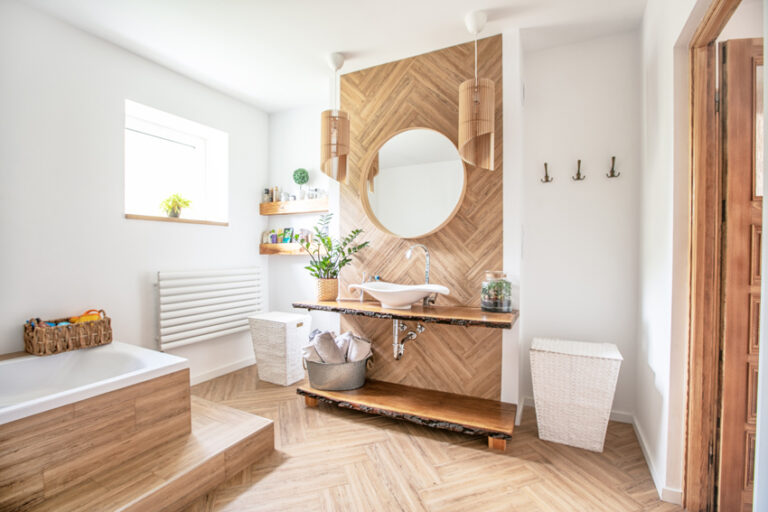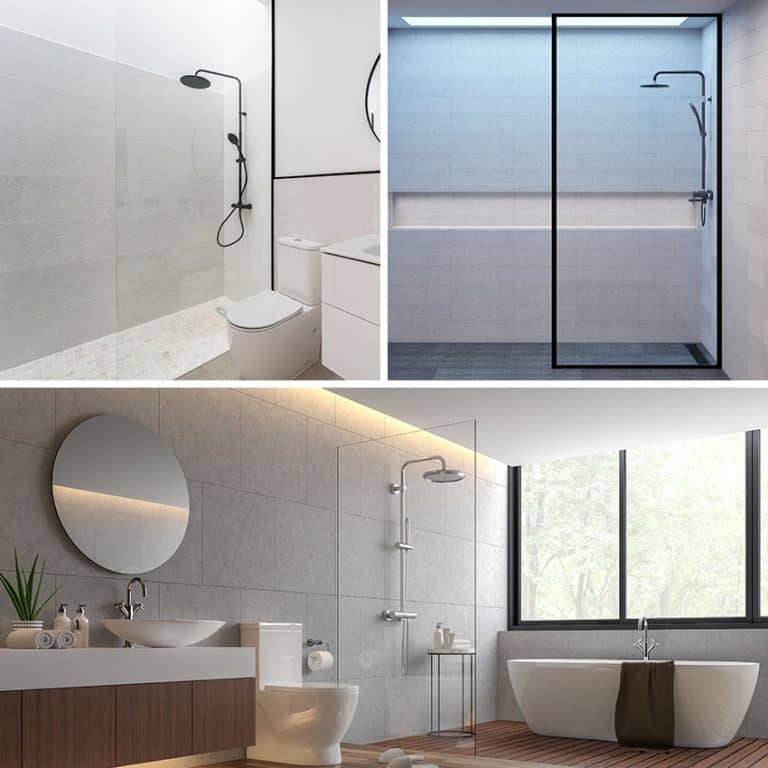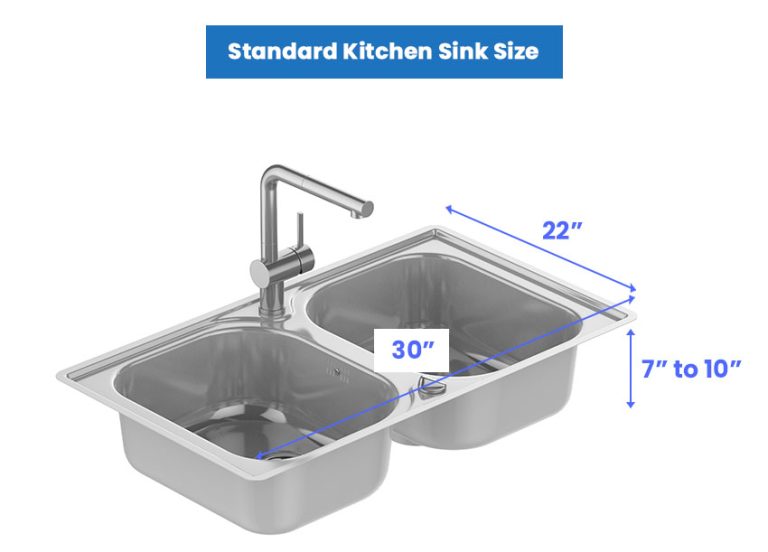Doorless Walk In Shower Dimensions
Here’s our doorless walk in shower dimensions guide with the standard & minimum stall sizes, opening space and the pros and cons of doorless walk-in showers.
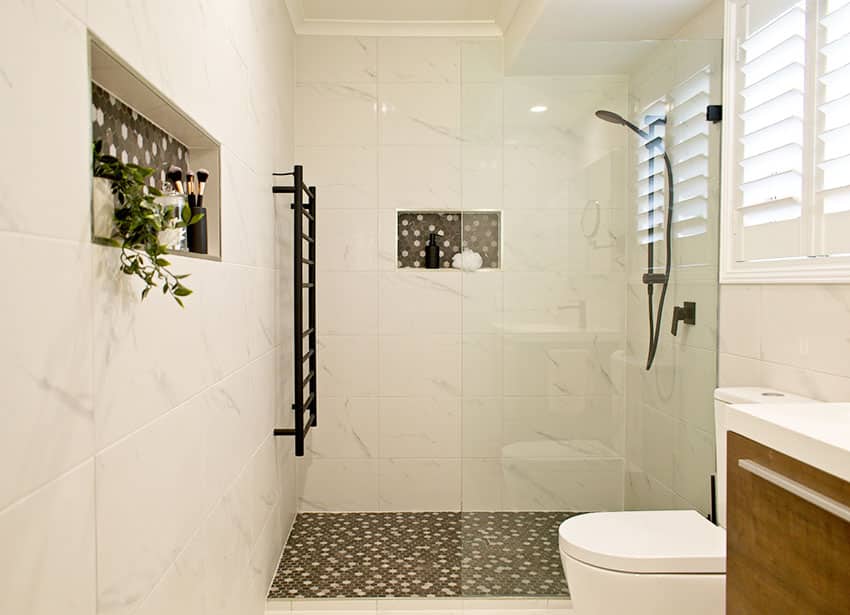
Doorless showers are another name for walk-in enclosures. They are those chic doorless showers you see when you peruse design inspiration from Pinterest and other image-sharing sites.
Aside from the excellent design aspect it will add to your home; doorless showers will also add to the accessibility of your bathrooms, making them roomier and more open.
Choosing the doorless design for your showers has many pros and cons. There’s the fact that there is less area to clean, but on the other hand, it will come with a hefty price tag since they will be custom designed.
Minimum Doorless Walk In Shower Dimensions
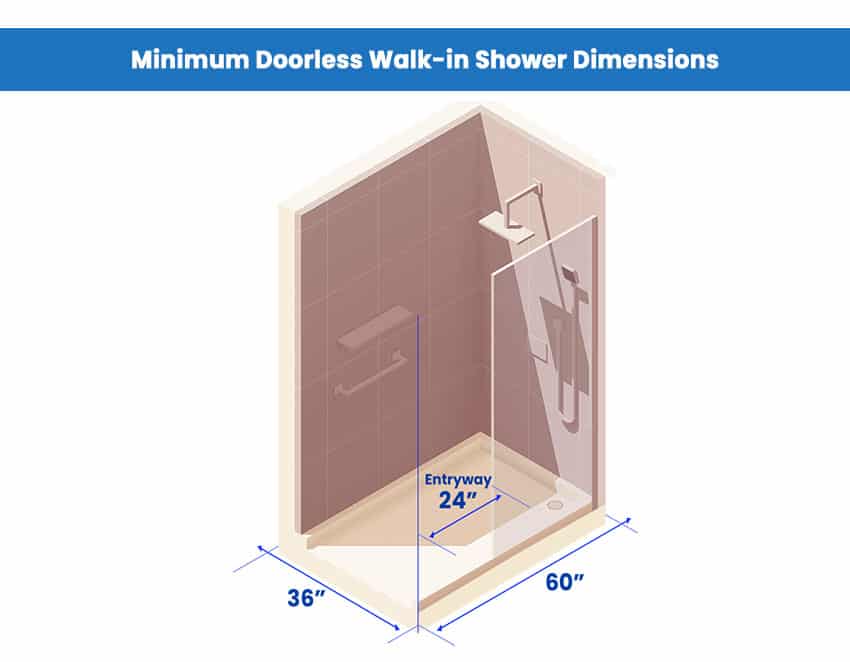
Ideally, a doorless or walk-in shower will require as much space as possible. This is another con, considering that it will require more space than your average stall. However, if you want one for your home, you must meet the minimum requirements required by most local codes.
The minimum doorless walk-in shower dimensions should have a standard shower stall size of 36 by 36 inches or 91 by 91 centimeters for the length and width and an additional entryway space of 24 inches or 61 centimeters.
All in all, this is a space that has a length of 5 feet or 60 inches and a width of 3 feet or 36 inches. If the minimum size is what will work best for your home, it’s best to position your shower in a corner to make sure that the floor space is maximized.
Doorless Walk In Shower Opening Size
A doorless walk-in requires an opening space. This opening space will ensure that no water will escape or splash into the bathroom. This opening space is essential since water or soapy water splashes can cause unwanted accidents.
A doorless shower opening should have an entryway space of at least 2 feet or 24 inches. You can go bigger if you want, especially with a large bathroom size.
To figure out a suitable entryway space, it is best to ask for expert advice from your contractor or the people who will do the remodeling for you. Aside from the recommended splash zone area, there still might be additional space allowance that will be needed depending on where your doorless shower is located because some homes will have them in the middle of the room.
How Big Should A Shower Be Without A Door?
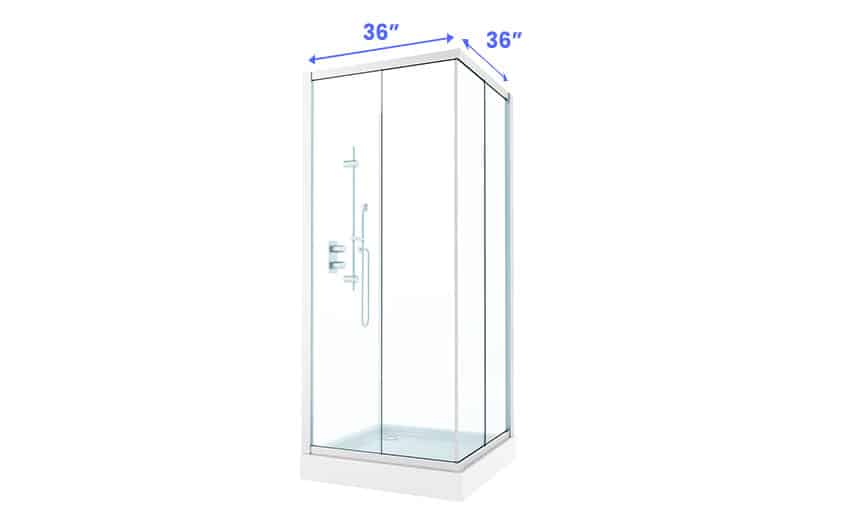
The best bet you can have is to ensure that your doorless shower will be accessible to everyone by following the requirements set forth by the Americans with Disabilities Act or ADA. Read more at the Access-Board website.
The minimum size for a doorless or walk-in shower is 36 by 36 inches or 91 by 91 centimeters. This size will be enough to accommodate a sitting bench affixed on the wall for any person with a disability to use the bathing area comfortably.
An opening size of 36 inches or 91 centimeters is also recommended to ensure the opening can fit a roll-in shower chair. You can go more extensive than this, considering some requirements, but anything smaller than this standard size would not be able to be as accessible for everyone.
How Big Should A Walk-in Shower Gap Be Between Vanity?
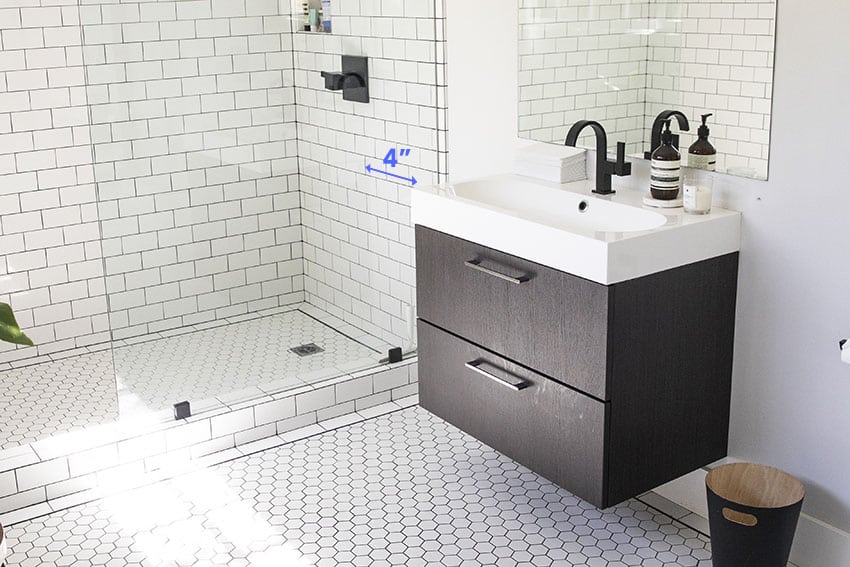
The great thing about doorless or walk-in shower designs is they do not need another additional space allowance that traditional shower stalls require, like the extra space allowance of 21 to 30 inches for the door to swing outwards.
However, there are still some considerations, like how close the vanity should be to the walk-in enclosure, especially for smaller bathrooms. Is it okay to have it flushed against the glass?
If the sheet of shower glass will act as a wall, a minimum space of 4 inches or about 10 centimeters is required between the bathroom vanity or sink and the glass or other enclosure of your doorless or walk-in design.
Doorless Shower Splash Zone
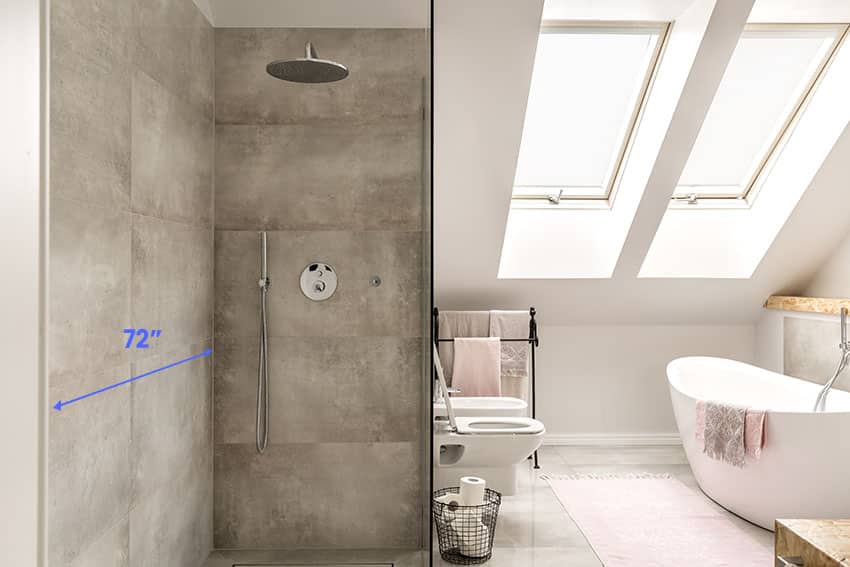
The splash zone required for a doorless or a walk-in shower is essentially the entryway space needed so that no water will spill out of the walkway space when people are showering.
Usually, this is 2 feet or 24 inches of space, but leaving at least 6 feet or 72 inches of open space adjacent to the shower’s entryway for the splash zone is the safest route.
This space will ensure that no furniture will be wet after your showers, and it will also allow maximum accessibility for everyone utilizing the enclosure, even people using wheelchairs.
How to Lessen Water Splash From a Doorless Walk-In Shower Design?
1. Specify a rainfall or a narrow showerhead. A rainfall showerhead with a 1.5 gpm rate with a fixed spray pattern will reduce water from splashing off. Traditional showerheads can be repositioned away from the entrance.
2. Consider the splash zone when laying out fixtures. It is determined that 70% of the water used in the shower falls within 23.6 inches or 600mm from the showerhead. Thus, positioning fixtures at least 2 ft or .6 m away from the showerhead minimizes furnishings getting wet.
3. Add a shower screen. Small bathrooms will have limited space, and giving away 2 feet or 600 mm for clearance may be too valuable if not possible. Frameless or framed glass is a popular way to integrate a shower screen while still allowing light to pass through. If privacy is a concern, frosted glass or textured glass panels can be an option.
4. Ensure proper drainage. A sloped floor can help direct water toward the drain and prevent water from pooling in the enclosure. The generally recommended slope of shower drains ranges from 2% to 4%. Ensure the floor is adequately sloped towards the drain during construction.
5. Opt for a trough drain. A trough drain is a long, narrow drain that runs along the length of the enclosure floor. It can help catch the water that may splash outside the showering area and direct it toward the drain.
6. Add a shower mat. A quick way to prevent slippage from water splashes is simply adding a shower mat. A mat can help absorb excess water and prevent slipping. Choose a mat with a non-slip backing and regularly clean it to prevent mold and mildew growth.
Do Walk-in Showers Need Doors?
Walk-in showers will have no doors. However, they can still have some kind of enclosure like a glass box to allow cohesiveness and design to your bathroom.
Glass shower doors and walls are there so that there is a separation between your enclosure and the toilet or your vanity. This glass wall can also give you the privacy you need that walk-in showers are usually not known for by opting for a frosted glass or adding decals on the glass walls.
Is A Door Shower A Good Idea?
Walk-in showers are a great idea in general, but with the pros will also come some cons, and here is a rundown of some of them:
One main benefit of a doorless is the accessibility it will give every person showering. There will be no need for a step-over entrance or even a space for the glass entrance to pivot. This makes doorless showers great if you want to remodel your bathroom.
Customization is another thing that people love with walk-in showers because it will make their bathrooms more modern and have an open feel. Homeowners can also easily add features like a bench or shelving units for toiletries.
Some things that will make doorless or walk-in showers a bad idea are the bigger space requirement since it will need spaces like entryway or splash zones to ensure accessibility and safety to your bathroom.
Another con is the privacy tradeoff, although this can easily be remedied by privacy measures like choosing a frosted glass over a clear one for the enclosure.
Which Should You Choose, A Frameless or Framed Glass Bathroom Divider?
Frameless bathroom dividers are one of the hallmarks of a modern bathroom, and it has become one of the most popular updates today.
However, framed bathroom dividers are not totally out of the picture, as framed bathroom dividers have also been a popular alternative to conventional bathroom walls.
Frameless Shower Divider
Here we compare the benefits and disadvantages of frameless dividers:
Pros of a frameless shower design:
• Aesthetically, frameless glass dividers give that sleek and clean profile of the modern style and can be easily matched with modern materials.
• Allows for an unobstructed view of the shower area and lets in light from the bathroom.
• It is easier to clean as there are no frames or tracks to collect dirt and grime.
• Frameless glass bathrooms are a feature that’s appealing to potential buyers, not to mention a good source for an Instagram-worthy interior peek at a property listing.
Cons of a frameless shower design:
• Usually costs more than your framed dividers due to the quality and type of glass needed to create a sturdy glass panel divider.
• While most frameless glass dividers recommended by a contractor can withstand impact, a framed divider with the same glass but added support will be sturdier. Furthermore, users may also feel more at ease with a framed divider.
• Typically require expert installation, which can be an added cost unless the manufacturer provides free installation due to warranty.
Framed Bathroom Divider:
Here’s some of the pros and cons of a framed shower divider.
Pros of a framed shower divider:
• Wide price range and is generally more affordable than frameless glass dividers.
• Less exposed due to the framing.
• Wide range of designs with different framing materials.
• Generally, more durable and sturdier than frameless dividers.
• Easier to install as there are no special installation techniques required.
Cons of a framed shower divider:
• It can be less visually appealing than frameless dividers.
• It can collect dirt and grime in the frames and tracks, making it harder to clean.
• The framing can obstruct the visual flow through the bathroom area.
Best Glass for a Frameless Shower Divider
• Tempered Glass
• Laminated Glass
• Frosted Glass
• Lacquered Glass
When it comes to choosing glass for a frameless shower divider, tempered glass is often the best choice. Tempered glass is treated to be more durable and resistant to breaking than regular glass, making it a safer option for use in showers where slips and falls are common.
Another popular option for shower dividers is laminated glass. Laminated glass consists of multiple layers of glass that are fused together with a layer of plastic in between, which makes it even stronger than tempered glass.
Visit our gallery of the types of shower designs for more related content.




